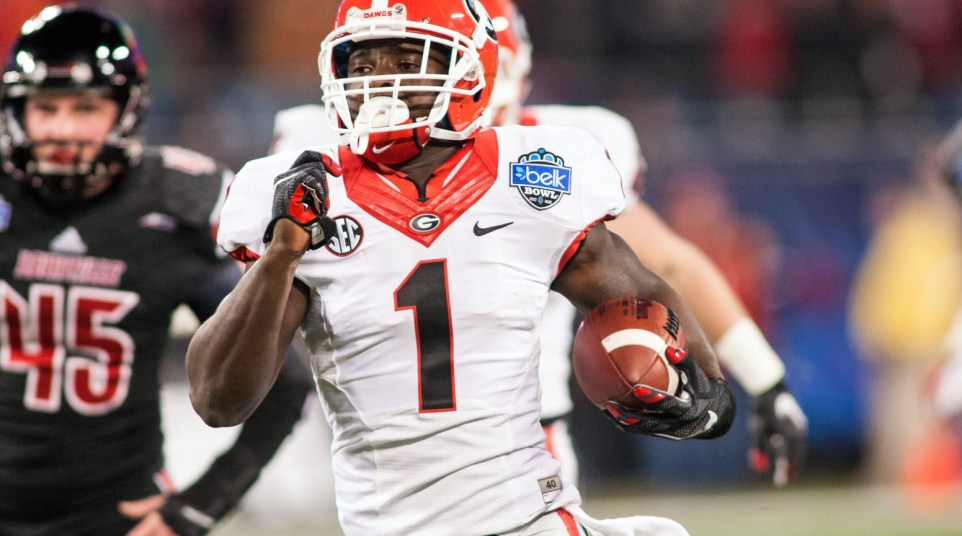Who will steal carries from Fournette, Henry and Chubb?
How the SEC’s three top running backs will perform in 2015 is one of the most compelling stories entering the season.
Running back lovers didn’t get the production you wanted in ’14 from players like Todd Gurley, T.J. Yeldon and Mike Davis, in part due to health issues.
Thankfully, there’s a lot of well-placed optimism surrounding LSU’s Leonard Fournette, Alabama’s Derrick Henry and Georgia’s Nick Chubb this season. (We see you, Jonathan Williams, Alex Collins, Russell Hansbrough and Jalen Hurd.)
Those three players should stay in contention for the Doak Walker Award all season, and depending on how the year breaks, could get some Heisman Trophy talk as well.
Which of those players will become the SEC’s top guy at running back in 2015? The answer may depend largely on health, but there’s a second influential factor: how their respective teams distribute the carries.
LSU, Alabama and Georgia all have capable backups to varying degrees. Those backups could do more to determine the SEC’s best running back in ’15 than Fournette, Henry or Chubb.
Which players are capable of taking away carries from the Big Three?
LEONARD FOURNETTE, LSU
There’s a clear No. 2 running back at LSU, and not much beyond that.
Kenny Hilliard (seventh-round pick, Houston) and Terrence Magee (undrafted free agent, Baltimore) are gone, as is fullback Connor Neighbors (undrafted free agent, Tennessee).
Darrell Williams, a 6-foot, 230-pound sophomore to be, got double-digit carries in three games last season. His combined totals in those games: 34 carries, 185 rushing yards and one touchdown. That’s 5.4 yards per rush. That’ll play behind Fournette and LSU’s offensive line.
There won’t be many other players spelling Fournette in ’15. David Ducre, the same height as Williams and 10 pounds heavier, was recruited as a fullback, and is competing with John David Moore for that job right now. But he’s the de facto third running back on the current projected depth chart.
Beyond that, four-star freshmen Derrius Guice and Nick Brossette have yet to arrive on campus.
With the team still unable to locate a strong quarterback between Anthony Jennings and Brandon Harris, Fournette should get all the carries he can handle this fall.
DERRICK HENRY, ALABAMA
Henry did not break the high school football career rushing record by splitting time in the backfield. But there usually are too many talented players in Tuscaloosa for that sort of self-indulgence.
But this is a unique season. Yeldon and Jalston Fowler got drafted by NFL teams last week. Bo Scarbrough tore his ACL. The Crimson Tide booted Tyren Jones from the team. Altee Tenpenny elected to transfer.
Kenyan Drake is rounding into form after breaking his leg last season, and there are indications that offensive coordinator Lane Kiffin will use him in a less-conventional running back role similar to Reggie Bush during his USC days.
That leaves true freshman DeSherrius Flowers, an early enrollee, and true freshman Damien Harris, a five-star signee due this summer.
All three of those players — Drake, Flowers and Harris — probably will play a role. But Henry is 6-foot-3, 242 pounds, and can absorb blows as well as any big-time running back in college football outside of Pitt’s James Conner. Of the big three, he faces the smallest impediment from the rest of his backfield and could be tasked with the biggest workload.
NICK CHUBB, GEORGIA
At times during the middle of last season, Chubb nearly represented the totality of the Georgia offense. He shouldered a righteous 42 offensive touches in his first career start against Missouri, 33 in a bowl win against Louisville and 31 against Arkansas.
Though Chubb averaged 7.1 yards per carry, his best, or at least most important, trait in 2014 was his durability.
Georgia will not want to rely on that exclusively this fall, preferring to ensure Chubb continues producing all season. It will be easier, at least in theory, with Sony Michel (career 6.4 yards per carry), Keith Marshall (5.6) and A.J. Turman (zero career carries).
The biggest X factor in Georgia’s offense this season, and especially in the backfield, is health.
Marshall has not been able to stay on the field consistently since his freshman season in 2012, and did not play in the spring game as he recovered from a hamstring injury. Michel, who missed time last season due to injury, didn’t play in the spring game because of a shoulder injury. A foot injury sidelined Turman last season.
All three of those players are capable of being very good SEC running backs when healthy. If at least two of them stay available at any given time, Chubb’s numbers could plateau or perhaps even decline a touch if he can’t duplicate the preposterous 7.1 yards per carry.
Chubb didn’t start the first five games last season and still reached 237 offensive touches. That’s an average of 20 per game. Considering UGA ideally will rest him some against opponents like Louisiana-Monroe, Southern and Georgia Southern, that seems like a reasonable number to expect again in 2015.
Among the Big Three, Georgia’s other running backs by far are the most interesting to monitor.

